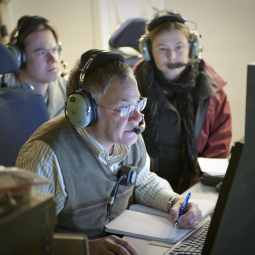By Kassandra Bell
When rings were first discovered around the planet Uranus, Allan Meyer was there. When water erupted out of Halley’s Comet, Allan Meyer was there, too. He wasn't in space but in the stratosphere, operating the telescope on a NASA airborne observatory.
Since 1976, Allan Meyer has been a team member on missions exploring the universe through wide, newly opened infrared “windows” in the electromagnetic spectrum. To date, Meyer has flown on a total of more than 900 overnight science flights aboard NASA’s Learjet Observatory (LJO), the Kuiper Airborne Observatory (KAO), and the Stratospheric Observatory for Infrared Astronomy (SOFIA). He has assisted with observations high above the United States, New Zealand, Samoa, and other locations around the world that led to new discoveries and advances in astronomy.
Recently, the University of Stuttgart recognized Meyer’s 35-year career in airborne astronomy by presenting him with an honorary doctorate. The University of Stuttgart, home to the German SOFIA Institute, is a partner in the development and operation of NASA’s newest airborne observatory.
“I'm infinitely grateful,” says Meyer, “It was earned by my work in the field over the entire course of my career” – a career that is not over yet.
Allen Meyer’s explorations in infrared astronomy began when he earned his bachelor’s and master’s degrees in physics at the University of California Santa Cruz in 1974. At that time UCSC, with one of the world’s premier astronomy departments, only offered one class that even touched on the emerging field of infrared astronomy.
“I was doing conventional ground-based optical astronomy using telescopes on mountain tops, and the only other kind of astronomy going on at that time was radio astronomy,” he recalls. “Infrared astronomy remained an esoteric new field into the 1970s, I just happened to have fortuitous timing to be here at Ames then.”
Meyer began working at NASA’s Ames Research Center in 1976 performing data analysis and later assisting with infrared measurements from NASA’s Learjet Observatory that carried a 10-inch telescope. He specifically remembers working on spectra of Venus that showed the planet's clouds were quite unlike the clouds of Earth, composed of aerosols of sulphuric acid instead of water.
Shortly thereafter, the KAO, a C-141 cargo jet outfitted with a 36-inch telescope, began its airborne operations. Meyer was one of the first invited to join that team. He worked with the KAO’s telescope tracking system and more than 50 onboard science instruments. “Some instruments measured the brightness of objects, some their spectra. They used the gamut of relevant technology to make those observations,” he explained.
Many of the instruments could not be tested on the ground because most infrared radiation is blocked by water vapor in the atmosphere. Thus, many of Meyer's KAO flights involved testing and calibrating instruments. Only once an instrument was fully tested would it be used to study celestial targets. “It was an attractive challenge to be faced with,” he recalls, “It was like being a detective collecting clues.”
In more than 800 flights on the KAO, Meyer participated in pioneering observations including characterizing the gas and dust clouds orbiting around the supermassive black hole at the center of our galaxy. That research was done with Nobel laureate Charles Townes, co-inventor of lasers. The KAO observations indicated that dust in the Milky Way’s nucleus is warmer the nearer it is to the central black hole, which therefore must be a source of radiation. “The hypothesis that a black hole is there had been around for years. At the time it was certainly exciting to get some better clues to what was going on at the center of the galaxy,” said Meyer.
Meyer was also onboard the Kuiper when observations of Halley’s Comet were made showing that the comet’s nucleus is composed mostly of water ice. “We concluded that we were seeing water that had burst suddenly out of the comet, like a geyser.”
Other advances in astronomy made possible by KAO observations helped by Meyer include:
- Observations of Orion and other parts of the Milky Way that led a new model of star formation;
- Determination of how elements other than hydrogen and helium vary in abundance across the galaxy;
- Comprehensive observations of Supernova 1987A that exploded in one of the Milky Way’s satellite galaxies; and
- Discovery of the rings around Uranus.
“These serve as examples of why people do this sort of research even when it's difficult and challenging,” says Meyer. “They represent our best shot at understanding the nature of the universe, the formation of stars, and the origin of Earth.”
Meyer’s airborne astronomy career continues on SOFIA as an associate scientist. He has been part of the program since its inception and has flown on 19 SOFIA missions to date.
Meyer’s diploma from the University of Stuttgart reads, “Dr.-Ing. E.h.” which translates as an honorary doctorate in engineering, in recognition of his work in airborne astronomy, especially during research with the Kuiper Airborne Observatory (KAO) and the Stratospheric Observatory for Infrared Astronomy (SOFIA).
"We're all very pleased that Allan Meyer has been recognized for his contributions to astronomy. This honor is long over-due," said Erick Young, director of SOFIA’s Science Mission Operations. "He brings an astounding breadth of airborne infrared astronomy experience to the SOFIA program. His insight about celestial targets and how they are best seen through an airborne telescope is invaluable."
SOFIA is a joint project of NASA and the German Aerospace Center (DLR). The aircraft is based at the Dryden Aircraft Operations Facility in Palmdale, Calif. NASA's Dryden Flight Research Center in Edwards, Calif., manages the program. Ames manages the SOFIA science and mission operations in cooperation with the Universities Space Research Association (USRA) in Columbia, Md., and the German SOFIA Institute (DSI) at the University of Stuttgart.
